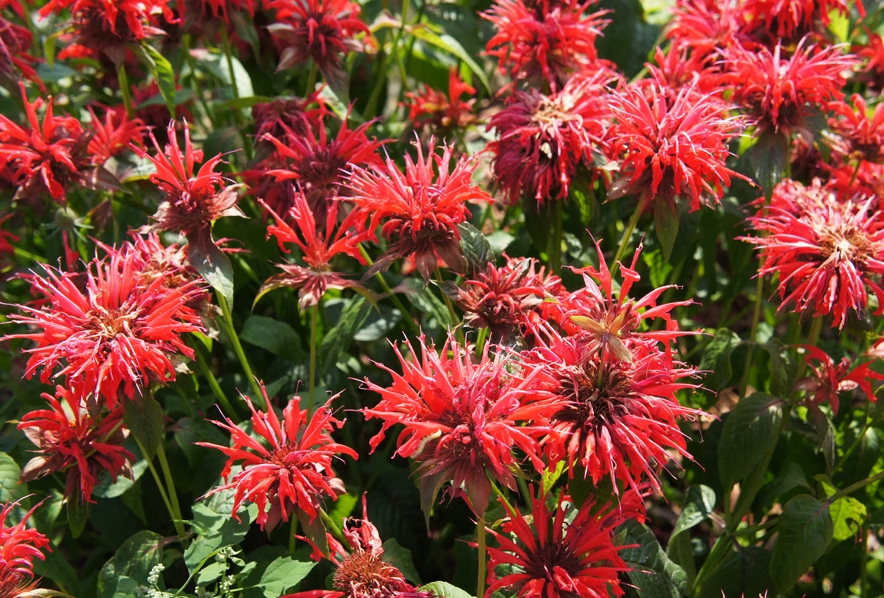
Bee Balm
Botanical Name
:
Monarda spp.
Plant Type
:
Flowering perennial
Seasons
:
Plant in spring or fall; Blooms in summer and fall
Sun Level
:
Full sun with good air circulation; at least six hours of full sun daily
Ideal Soil Temperature for Planting
:
Aim for a soil temperature between 65–70°F (18– 21°C)
Soil Type
:
Moist soil rich in organic matter; well-drained soil
Germination
:
Typically occurs within 10 to 25 days after sowing, but can sometimes take as long as 30 days
P.H. Level
:
6.0–7.0
Water/Irrigation
:
Consistent, moderate watering to maintain evenly moist soil; at least 1 inch of water per week
Fertilization
:
Generally not necessary as it thrives in soil rich in organic matter; if needed, use a slow-release 10-10-10 fertilizer in early spring, or top-dress with compost
Habit
:
Mounding
Propagation
:
Division, seed, pruning
Final Plant Height
:
4 ft tall, with dwarf varieties reaching only 15 inches in height
Spread
:
3–4 ft, but dwarf varieties have a spread of 18–24 inches
Flowers
:
Open, daisy-like shape, with tubular petals in shades of red, pink, purple, and white
Attracts
:
Bees, butterflies, hummingbirds, pollinators, songbirds
Uses
:
Pollinator gardens, cottage gardens, and borders. In herbal medicine and teas to help manage digestion issues like bloating and nausea
Companions
:
Basil, squash, cucumbers, turnips, and tomatoes
Pruning
:
Prune by one-third to one-half in the spring to promote compact growth and encourage later blooming.
Toxicity
:
Non-toxic to both humans and pets
Pests
:
Aphids, spider mites, thrips, and stalk borers
Diseases
:
Fungal diseases like powdery mildew
Fun Fact
:
The name “bee balm” comes from a popular salve made from its resin, traditionally used to soothe bee stings
Additional Info
:
Provide good air circulation to reduce the risk of powdery mildew
Botanical Name
:
Monarda spp.
Plant Type
:
Flowering perennial
Seasons
:
Plant in spring or fall; Blooms in summer and fall
Sun Level
:
Full sun with good air circulation; at least six hours of full sun daily
Ideal Soil Temperature for Planting
:
Aim for a soil temperature between 65–70°F (18– 21°C)
Soil Type
:
Moist soil rich in organic matter; well-drained soil
Germination
:
Typically occurs within 10 to 25 days after sowing, but can sometimes take as long as 30 days
P.H. Level
:
6.0–7.0
Water/Irrigation
:
Consistent, moderate watering to maintain evenly moist soil; at least 1 inch of water per week
Fertilization
:
Generally not necessary as it thrives in soil rich in organic matter; if needed, use a slow-release 10-10-10 fertilizer in early spring, or top-dress with compost
Habit
:
Mounding
Propagation
:
Division, seed, pruning
Final Plant Height
:
4 ft tall, with dwarf varieties reaching only 15 inches in height
Spread
:
3–4 ft, but dwarf varieties have a spread of 18–24 inches
Flowers
:
Open, daisy-like shape, with tubular petals in shades of red, pink, purple, and white
Attracts
:
Bees, butterflies, hummingbirds, pollinators, songbirds
Uses
:
Pollinator gardens, cottage gardens, and borders. In herbal medicine and teas to help manage digestion issues like bloating and nausea
Companions
:
Basil, squash, cucumbers, turnips, and tomatoes
Pruning
:
Prune by one-third to one-half in the spring to promote compact growth and encourage later blooming.
Toxicity
:
Non-toxic to both humans and pets
Pests
:
Aphids, spider mites, thrips, and stalk borers
Diseases
:
Fungal diseases like powdery mildew
Fun Fact
:
The name “bee balm” comes from a popular salve made from its resin, traditionally used to soothe bee stings
Additional Info
:
Provide good air circulation to reduce the risk of powdery mildew
Written by Nondiah Khalayi – https://www.linkedin.com/in/nondiah-khalayi/

